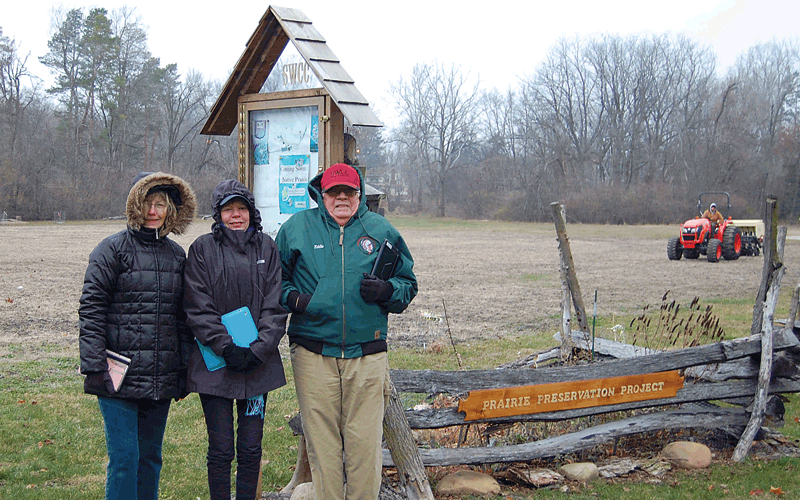AN URBAN PRAIRIE IN WAYNEDALE

The morning of December 8, 2016, was downright chilly. At 7:15 a.m., the overnight temperature had dropped to 22 degrees with 20 mph winds whipping around snow flurries. Daybreak on this morning was gloomy and grey at the Southwest Conservation Club (SWCC) on Bluffton Road. Turns out, it was a perfect day for planting.
Because of a grant from the Indiana Native Plant and Wildflower Society (INPAWS), a full acre of SWCC’s property was being restored to native prairie. “It was cold, cold, cold. And windy,” says Nanette Coble, a Purdue Master Gardener. Along with her husband, Eddie Coble, the couple co-chairs the SWCC Prairie Restoration committee. Huddled together, they watched years of planning and labor take root. “We were excited to watch, but we had to keep darting into our car to keep warm.”
On any given day at the SWCC, local police officers use a rare within-city-limits firearms range, archers string bows for target practice, and sport shooters launch skeet. Amidst all the sporting equipment, this urban property may seem an unlikely place to find native prairie enthusiasts. Yet, conservation is a big part of what this club does.
Founded in 1938, and sitting on 37 acres, SWCC encompasses four ponds, a wooded hiking trail, a campground and nature study areas. In 2011, club members began brainstorming ways they could make a large, open expanse on their property more wildlife friendly. “Honestly, I was just tired of seeing weeds,” says Eddie. Plants were donated or purchased, and club and community members pitched in hundreds of volunteer hours to help return a section to a more natural state. They removed invasive species and installed several native plant “welcome” gardens. Work was slow going and expensive for the member-supported club. It was a start, but it wasn’t enough.
In 2015, Southwest Honey Company (SWHC), an organization dedicated to public education about bees and other pollinators, set up a four-hive apiary on the grounds. Alex Cornwell, manager of SWHC, says that the bees helped the membership think differently about club goals. “Members started taking ownership of the bees, asking what more they could do to help,” Cornwell says. That’s when Nanette received a bit of inspiration. “Bees and prairie flowers go hand-in-hand,” Nanette said. “I looked around and saw few food sources available to the bees.” To Nanette, the open parcel of land and weeds in front of their clubhouse started to look less like an eyesore, and more like an opportunity. “I thought the large one-acre area would be the perfect place for a restored native prairie.” With visions of attracting birds, butterflies, bees, and other pollinators, club members shifted strategy.
“The entire multi-year process brought the conservation club back into conservation mode,” Cornwell says.
Eddie said that the club discussed ways to obtain funds to help further their conservation cause. The idea of reaching out to INPAWS grew from that discussion. Club members, Purdue Master Gardeners, native plant nurseries and landscape designers all chipped in their expertise to help formulate a plan and write the grant. “We asked for a lot in our grant proposal to INPAWS, almost $1,000,” Eddie said. “Honestly, though, I thought we had a 100 percent chance of success because it was a community effort.” Nanette adds, “Before we were the dreamers. Now we’re the doers.”
On that cold December morning, their dreams became reality.
Heartland Restoration Services, a local native landscape restoration company, brought its heavy equipment and the Midwestern ecotype seed purchased with the INPAWS grant. Mike Van Laeken, director of restoration services for Heartland, said the December date and cold temperature gives the planting a great start to successful germination. “We pick those kinds of mornings because our native seed no-till drill can penetrate that frozen ground,” Van Laeken says. “And the snow, along with the frost-thaw cycle, can help push the seed further into the ground.”
The seed mixture consisted of wildflowers native to the area and short and tall native grasses. Van Laeken says that’s an important distinction. “We don’t bring in species, say, from Texas,” he said. “We only use species from sources that will handle the climate of the Great Lakes region.” The Cobles were impressed. “The drill planter looked a bit like a garden tractor, but the process was very precise,” Eddie said. “Heartland fully planted that acre. I just can’t say enough about its professionalism.”
Within two hours, Indiana had gained a new prairie.
SWCC is grateful for the INPAWS grant. The club knows that its new prairie exists because of investments made by INPAWS members throughout the state, so it takes its stewardship responsibility seriously.
Now that the seed is in the ground, other plans can move forward. Nanette shares the club’s five-year vision, which includes a trail through the prairie, a path to the beehives, garden signage and programs. “With the prairie and the apiary, we can educate children about the crucial role native species play in a healthy Indiana ecosystem,” Nanette said. “They’ll be able to interact with nature in a beautiful, colorful way.” In addition to an increase in educational opportunities, Eddie says the club is excited to see an increase in wildlife.
“We can hardly wait for spring!”
To learn more about INPAWS, visit www.inpaws.org.
- RARE SCHOOL WOODLAND PROPERTY GAINS NEW SUPPORT - April 14, 2017
- AN URBAN PRAIRIE IN WAYNEDALE - January 20, 2017
- RARE INDIANA HABITAT RESTORED, ONE SEED AT A TIME - November 4, 2016


